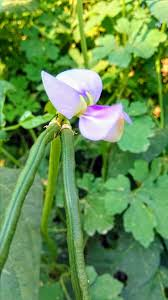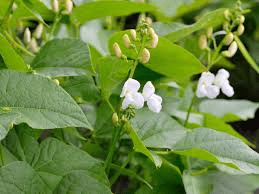Beans flowers are a vital part of the bean plant, playing a crucial role in its reproductive cycle. These flowers, typically small and often white, pink, purple, or yellow, are not only important for the development of bean pods and seeds but also contribute to the plant’s overall aesthetic appeal in gardens and fields.
Beans flowers are borne on racemes, which are clusters of flowers arranged along a central stem. Each flower is composed of several parts, including the calyx, corolla, stamens, and pistil. The calyx is the outermost whorl of the flower, made up of sepals that protect the developing bud.
The corolla consists of petals, usually five in number, that attract pollinators with their color and scent. The stamens, the male reproductive organs, produce pollen, while the pistil, the female reproductive organ, contains the ovary, style, and stigma.
Pollination in bean flowers can occur through self-pollination or cross-pollination. In self-pollination, pollen from the stamens is transferred to the stigma of the same flower, ensuring fertilization even in the absence of pollinators.
Cross-pollination involves the transfer of pollen from the stamens of one flower to the stigma of another flower, often facilitated by wind, insects, or other pollinators. While beans are predominantly self-pollinating, cross-pollination can occasionally occur, leading to genetic diversity within the plant population.
Once fertilization takes place, the ovary of the flower develops into a pod containing seeds. The process begins with the growth of the ovule into a seed and the expansion of the ovary walls to form the pod. As the seeds mature, the pod enlarges and eventually reaches full size. The time from pollination to mature pod formation varies depending on the bean variety and growing conditions, but it typically ranges from a few weeks to a couple of months.
Bean flowers are not just functional; they also offer ecological benefits. By attracting pollinators such as bees and butterflies, bean flowers support biodiversity and the health of the ecosystem. These pollinators, in turn, help other plants in the vicinity by facilitating cross-pollination, which is crucial for the reproductive success of many plant species.
Cultivating bean plants requires attention to their flowering period, as this is a critical phase in the plant’s life cycle. Ensuring adequate sunlight, water, and nutrients during this time is essential for robust flower development and subsequent pod formation. Bean plants generally prefer well-drained soil, consistent moisture, and a moderate climate to thrive and produce abundant flowers and pods.
From an agricultural perspective, understanding the flowering process of beans can help improve crop yields. Practices such as selecting the right bean varieties, optimizing planting times, and managing pests and diseases are crucial for ensuring healthy flower development and successful pod production. Additionally, supporting pollinator populations through the creation of pollinator-friendly habitats can enhance the pollination process and improve bean yields.
Bean flowers are integral to the reproductive cycle of the bean plant, leading to the development of pods and seeds. These small, colorful flowers are typically self-pollinating but can also benefit from cross-pollination. Proper care during the flowering period, including adequate sunlight, water, and nutrients, is essential for successful pod formation.
Bean flowers also contribute to ecological health by attracting pollinators and supporting biodiversity. Understanding the flowering process and its requirements is key to optimizing bean crop production and ensuring healthy, productive plants.
The Economic Importance and Uses of Beans Flowers

1. Pollination: Beans flowers attract pollinators such as bees, butterflies, and other insects, facilitating the pollination process essential for bean production.
2. Seed Production: Beans flowers develop into pods that contain seeds, crucial for the propagation and cultivation of bean crops.
3. Crop Yield: Successful flower pollination leads to higher crop yields of beans, contributing to agricultural productivity and food security.
4. Genetic Diversity: Beans flowers contribute to genetic diversity within bean species through cross-pollination, ensuring robust plant populations.
5. Culinary Use: In some cultures, bean flowers are edible and used as an ingredient in culinary dishes, adding a unique flavor and visual appeal.
6. Ornamental Value: Certain varieties of beans, such as scarlet runner beans, are cultivated for their ornamental flowers in gardens and landscaping.
7. Medicinal Uses: Extracts from bean flowers are used in traditional medicine for their potential health benefits, although research in this area is ongoing.
8. Botanical Research: Beans flowers are studied in botanical research to understand plant reproduction, genetics, and evolutionary biology.
9. Beekeeping: Beans flowers provide nectar and pollen for bees, supporting beekeeping activities and honey production.
10. Aesthetic Appeal: Beans flowers enhance the aesthetic appeal of agricultural landscapes and gardens, attracting tourists and visitors.
11. Educational Purposes: Beans flowers are used in educational settings to teach students about plant biology, pollination processes, and agricultural practices.
12. Bee Conservation: Beans flowers support bee populations, contributing to biodiversity and ecosystem stability in agricultural regions.
13. Environmental Indicators: The presence and health of beans flowers can serve as indicators of soil fertility, ecosystem health, and environmental conditions.
14. Cultural Significance: In some cultures, beans flowers hold cultural significance and are used in traditional ceremonies and rituals.
15. Seed Saving: Beans flowers are essential in seed-saving practices, ensuring the preservation and propagation of heirloom and native bean varieties.
16. Culinary Innovation: Chefs experiment with beans flowers in culinary innovations, exploring new flavors, textures, and presentations in dishes.
17. Soil Fertility: Beans flowers contribute to soil fertility by supporting beneficial soil microorganisms and nutrient cycling processes.
18. Agricultural Research: Beans flowers are studied in agricultural research to develop improved bean varieties with enhanced yield, disease resistance, and nutritional content.
Read Also: The Important Records to keep on your Ruminant Farm
The Products and By-products That Can Be Derived From Beans Flowers

1. Edible Flowers: Some bean flowers are edible and used in culinary dishes for their unique flavor and visual appeal.
2. Herbal Teas: Dried beans flowers can be steeped to make herbal teas, valued for their potential health benefits.
3. Botanical Extracts: Extracts from beans flowers are used in the formulation of herbal supplements and medicinal products.
4. Cosmetic Ingredients: Beans flower extracts are used in cosmetics and skincare products for their soothing and antioxidant properties.
5. Floral Arrangements: Fresh beans flowers are used in floral arrangements for decorations, events, and ceremonies.
6. Aromatic Oils: Essential oils extracted from beans flowers are used in aromatherapy and fragrance industries.
7. Bee Products: Beans flowers provide nectar and pollen for bees, supporting honey production and beekeeping activities.
8. Biodegradable Confetti: Dried beans flowers are used as biodegradable confetti for eco-friendly celebrations and events.
9. Natural Dyes: Beans flowers can be used as natural dyes to color textiles and crafts with vibrant hues.
10. Potpourri: Dried beans flowers are added to potpourri mixes for their fragrance and aesthetic appeal.
11. Culinary Garnish: Fresh beans flowers are used as a decorative garnish in culinary presentations.
12. Herbal Remedies: Beans flower extracts are used in traditional herbal remedies for their potential medicinal properties.
13. Landscape Design: Beans flowers are incorporated into landscape design to enhance garden aesthetics and attract beneficial insects.
14. Agricultural Research: Beans flowers are studied in agricultural research to understand pollination dynamics, crop genetics, and plant breeding.
15. Seed Production: Beans flowers are crucial for seed production, ensuring the availability and propagation of bean varieties.
16. Organic Fertilizer: Dried beans flowers are composted to create organic fertilizer, enriching soil with nutrients.
17. Cultural Artifacts: Beans flowers are used in cultural artifacts, arts, and crafts to symbolize fertility, growth, and abundance.
Read Also: Importance of Records Maintenance in the Poultry Farm
Frequently Asked Questions (FAQ’s) About Beans Flowers

1. What are beans flowers?
Beans flowers are the reproductive structures of bean plants that develop into pods containing seeds.
2. Are beans flowers edible?
Some varieties of beans flowers are edible and used in culinary dishes for their flavor and aesthetic appeal.
3. How do beans flowers benefit agriculture?
Beans flowers facilitate pollination, leading to seed production and higher crop yields in bean farming.
4. Can beans flowers be used in herbal remedies?
Yes, extracts from beans flowers are used in traditional medicine and herbal remedies for potential health benefits.
5. Do beans flowers attract pollinators?
Yes, beans flowers attract pollinators such as bees, butterflies, and other insects essential for crop pollination.
6. Are beans flowers used in cosmetic products?
Yes, beans flower extracts are used in cosmetics and skincare products for their soothing and antioxidant properties.
7. How are beans flowers used in cultural traditions?
Beans flowers hold cultural significance in some traditions and are used in ceremonies, decorations, and symbolic representations.
8. What products can be made from beans flowers?
Products derived from beans flowers include edible flowers, herbal teas, botanical extracts, cosmetic ingredients, and natural dyes.
9. Are beans flowers important for biodiversity?
Yes, beans flowers support biodiversity by attracting beneficial insects and contributing to ecosystem health in agricultural landscapes.
10. How are beans flowers used in beekeeping?
Beans flowers provide nectar and pollen for bees, supporting honey production and beekeeping activities.
Read Also: How to Store Fresh Fruit, Vegetables and Herbs
